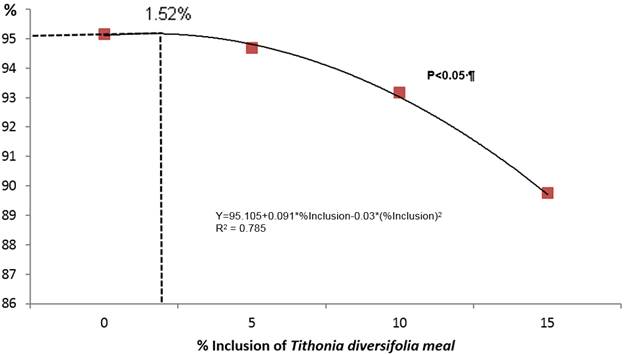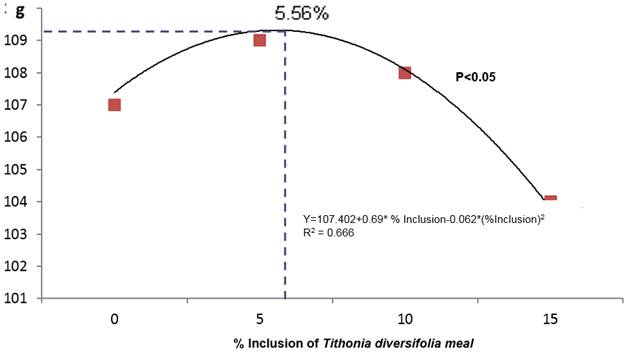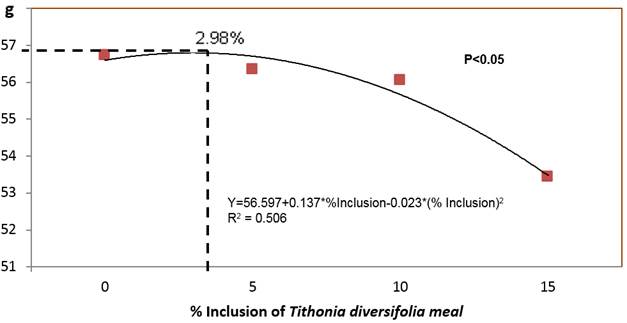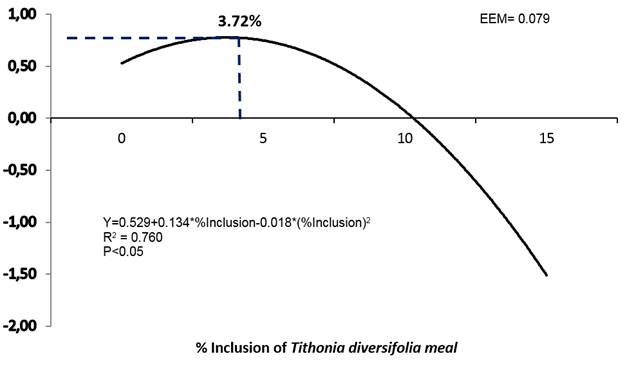INTRODUCTION
Within the current economic crisis and livestock production, promote the search for alternative foods that reduce costs without affecting the performance of animals, and one of these options are non-traditional foods that are a potential alternative to solve, even if partially, the problem of animal feed in Mexico. It should be mentioned that a non-traditional or unconventional food is "all natural product or obtained through a crop or resulting from obtaining a primary product not currently used, or used in a scanty way for animal feed, with a minimum of availability in determined periods; which will provide one or more nutrients required by the animal organism for its development, and be innocuous in the form and quantity supplied "(Rodríguez et al., 2018; Pérez-Gil et al., 2014; González-Castillo et al., 2014).
The present scarcity and threat of depletion of fossil fuels have certain limitations on the increase of agricultural productivity, even in developed countries. Greater restrictions exist in developing countries, due to their low agricultural productivity and population increase. In this regard it should be noted that some foods used in animal nutrition are also suitable for human consumption; therefore, there is a need to evaluate products with the possibility of replacing the traditionally used ingredients (sorghum, soy, corn, etc.) in animal feed. An alternative to this problem in this context may be the shrubby plant Tithonia diversifolia in the feeding of birds (Rodríguez et al., 2018, Betancourt et al., 2017, González-Castillo et al., 2014).
Tithonia diversifolia also known as marigold tree, golden button, Mexican sunflower, false sunflower, Nitobe chrysanthemum, Quil Amargo and Wild Sunflower (Martínez, 1979), is located in tropical and subtropical areas and has almost 15,000 species distributed throughout the world . This genus is present with 10 species in Central America and its center of origin is accepted in Central America or Mexico (Alonso et al., 2010). It grows at the edge of roads quickly, even under unfavorable conditions and multiplies easily. It can support pruning at ground level, burning and pruned branches are offered as livestock feed (González-Castillo et al., 2014). It is known that this species improves the recycling of nutrients, prevents erosion, reduces the effects of animal trampling on the soil and offers a high productivity of biomass without agrochemical inputs (Fernández, 2017). There is evidence that species of non-leguminous plants such as Tithonia diversifolia accumulate nitrogen and phosphorus; in addition to the ability to recover the scarce nutrients of the soil, with a wide range of adaptation; tolerating acidity conditions and low soil fertility (Mahecha and Rosales, 2005). It has been used as a multipurpose plant: live fence, green manure, food source in silvopastoral cattle or forage cut in the feed of birds and ruminants among other uses (Pérez et al., 2009). From the decade of the 90's studies were initiated to evaluate their forage potential and its use was recommended for the feeding of sheep, goats and bovines; as well as for monogastric animals (La O, 2012).
With this background, the objective of this research was to evaluate the effect of different levels of inclusion of Tithonia diversifolia meal, in rations for laying hens on the productive variables.
MATERIAL AND METHODS
Obtaining and determining the chemical composition of Tithonia diversifolia (HTD) flour. The collection was carried out in the Academic Unit of Veterinary Medicine and Zootechnics of the Autonomous University of Nayarit, located in Compostela, Nayarit, Mexico. Leaves and petioles (644.5 kg/fresh) were harvested manually at 60 days of regrowth and all non-research material was removed. They were pre-dried in shade and then finished drying in a drying oven at 60 °C/24 hours. They were milled in a hammer mill with 1 mm mesh, this mealwas stored in black plastic bags at room temperature and was carried out moisture analysis, ash, crude protein, ether extract and crude fiber (AOAC, 2005) ; as well as amino acid profile by HPLC (Waters, 1993).
Preparation of diets and behavior of the birds. All the procedures with the birds were approved by the Institutional Subcommittee for the Care and Use of Experimental Animals (SICUAE), Faculty of Veterinary Medicine and Zootechnics of the National Autonomous University of Mexico (NOM-062-ZOO-1999). The study was carried out in the Center for Education, Research and Extension in Poultry Production (CEIEPAv) of the Faculty of Veterinary Medicine and Zootechnics of the National Autonomous University of Mexico, Mexico City. 192 first cycle white Bovans hens were used; age 30 weeks, 11 weeks of production and average weight of 1,562 ± 0.051kg, housed in cages with 3 hens each in battery; with an average temperature of 16 °C. They were distributed in a completely randomized design, in 4 treatments with 4 repetitions of 12 birds each: 1) control diet; 2) 5% of HTD; 3) 10% of HTD and 4) 15% of HTD); water and food were offered ad libitum. The diets were formulated based on sorghum + soybean meal, meeting the nutritional needs of the lineage according to the production phase, with the Allix2 computer program. See. 5.37.1 (Table 1). During 10 weeks of trial with the birds, a weekly record of percentage of egg-lying, food consumption, weight and egg mass, feed conversion index, percentage of broken, dirty and in coltsfoot egg was taken.
Table 1 Experimental diets supplemented with Tithonia diversifolia meal (kg).
| Meal of Tithonia diversifolia | ||||
|---|---|---|---|---|
| Ingredient | Control | 5% | 10% | 15% |
| Sorghum | 660.100 | 621.402 | 539.721 | 456.940 |
| Soybean paste | 221.000 | 202.002 | 222.720 | 242.414 |
| Calcium carbonate | 101.791 | 98.000 | 94.033 | 90.112 |
| Meal of Tithonia diversifolia | 0.000 | 50.000 | 100.000 | 150.000 |
| Calcium phosphate | 4.568 | 4.553 | 4.361 | 4.183 |
| Salt | 3.026 | 3.046 | 3.057 | 3.068 |
| Premix of vitamins and minerals1 | 2.400 | 2.400 | 2.400 | 2.400 |
| DL-methionine 99% | 2.289 | 2.401 | 2.042 | 1.704 |
| Vegetable oil | 1.482 | 13.277 | 29.991 | 47.504 |
| L-Lysine HCl 78.8% | 1.179 | 1.246 | 0.000 | 0.000 |
| Choline chloride 60% | 0.500 | 0.500 | 0.500 | 0.500 |
| Vegetable red pigment2 | 0.800 | 0.800 | 0.800 | 0.800 |
| Vegetable yellow pigment3 | 0.500 | 0.000 | 0.000 | 0.000 |
| Antioxidant4 | 0.150 | 0.150 | 0.150 | 0.150 |
| Bambermycin | 0.125 | 0.125 | 0.125 | 0.125 |
| Fitasa5 | 0.100 | 0.100 | 0.100 | 0.100 |
| Total | 1000.0 | 1000.0 | 1000.0 | 1000.0 |
| Calculated analysis | ||||
| Metabolizable energy, kcal / kg | 2,800 | 2,800 | 2,800 | 2,800 |
| Crude protein, % | 17.4 | 17.4 | 18.97 | 20.48 |
| Methionine + total cystine,% | 0.73 | 0.73 | 0.73 | 0.73 |
| Total lysine,% | 0.86 | 0.86 | 0.866 | 0.967 |
| Total threonine,% | 0.622 | 0.625 | 0.691 | 0.754 |
| Total tryptophan,% | 0.205 | 0.189 | 0.196 | 0.201 |
| Raw fiber,% | 2.446 | 2.831 | 3.331 | 3.824 |
| Total calcium,% | 4.100 | 4.100 | 4.100 | 4.100 |
| Phosphorus available,% | 0.420 | 0.420 | 0.420 | 0.420 |
| Sodium,% | 0.180 | 0.180 | 0.180 | 0.180 |
1Content per kg: A; 4.0 MUI: D3; 666,666.7 IU: RovomixHyD; 5kg: K3; 1.67g: B1; 0.83g: B2; 2.33g: B6; 1.17g: B12; 6,666.67mg: Niacin; 10g: D-Pantothenic acid; 3.33g: Folic acid; 0.33g: Biotin; 33.33mg: Hill; 100g: Iron; 20g: Zinc; 26.67g: Manganese; 36.67g: Copper; 5g: mud; 0.33g: Selenium; 0.1g.
2Avired: 5g / kg (minimum) of xanthophylls of Capsicum spp.
3Florafil 93 Powder (Vepinsa): 30g / kg (minimum) of total xanthophylls.
4BHA; 1.2%: BHT; 9.0%: Etoxiquin; 4.8%: Chelating agents; 10.0%.
5Quantum Blue 5000 FTU / kg derived from E. coli.
Statistical analysis. For the productive variables, a design of measurements repeated over time was used (Kuehl, 2001); as well as an analysis of Multiple Regression (Kuehl, 2001) to find a biological optimum point, which was calculated from the following formula:
A transformation of variables (Kuehl, 2001) weight gain was performed to obtain homogeneity of variance, using the following formula:
The statistical package used was SPPS, version 21.0 for Windows, with level of significance 0.05.
RESULTS AND DISCUSSION
Chemical composition and amino acid profile of Tithonia diversifolia (HTD) flour. The chemical composition of HTD (Table 2), highlights the crude protein (27.44%). This result compared with other samples of Tithonia diversifolia (flowers, leaves, petioles and stems) was similar to that reported by García et al., (2008) (25.7%); however, there are other data that range between 18.26%, up to 29.79% (Lezcano et al., 2012; Ruíz et al., 2016). With respect to the content of essential amino acids, the HTD presented low content of these, in comparison to the soybean paste used as a source of protein in poultry, which reports 48% of PC and amino acids (g aa/100 g of protein) : methionine (0.70), cystine (0.73), lysine (3.02), threonine (1.90), valine (2.70) and leucine (3.8). Therefore, HTD contributes 90%, 70%, 70.8%, 70.5%, 91.8% and 55.2% of these amino acids respectively (Cuca and Avila, 2009).
Table 2 Chemical composition, amino acid profile and minerals in Tithonia diversifolia flour.
| Dry base | |
|---|---|
| Proximal analysis (g / 100g) 1 | |
| Total solids | 92.16 |
| Crude protein | 27.44 |
| Ethereal extract | 2.25 |
| Raw fiber | 12.11 |
| Ashes | 18.53 |
| Nitrogen free extract | 39.67 |
| Amino acids | (g aa/100 g of protein)2 |
| Methionine | 0.636 |
| Cystine | 0.577 |
| Methionine + Cystine | 1.213 |
| Lysine | 2.146 |
| Threonine | 1.348 |
| Aspartic acid | 3.010 |
| Glutamic acid | 2.191 |
| Proline | 2.153 |
| Glycine | 2.664 |
| To the girl | 1.947 |
| Valine | 2.482 |
| Isoleucine | 0.894 |
| Leucine | 2.103 |
| Serina | 1.978 |
| Phenylalanine | 1.386 |
| Arginine | 0.963 |
| Histidine | 0.376 |
| Minerals | (g/100g)1 |
| Phytic Phosphorus | 0.70 |
| Total phosphorus | 0.53 |
| Calcium | 3.15 |
| Sodium | 18.36 |
| Potassium | 5294.19 |
| Magnesium | 507.64 |
| Iron (mg/kg) | 412.31 |
1 n=6. 2 n=3
The contrast of reported results of this study and by other authors, could be explained by the different parts of the plant studied, the time of collection, age and geographical location of it.
Productive variables. No significant difference (P> 0.05) in egg-lying, broken, in coltsfoot and dirty egg was observed. With the different inclusion levels of HTD, plus the addition of a microbial use phytase (E. coli); independent to the decrease in calcium carbonate (up to 11.5%), and calcium phosphate (up to 8%). It can be said that when using a phytase it is possible to have available the phosphorus present in the HTD, and as mentioned by Frontela et al., (2008) and Cortés et al., (2007) observed that with the use of phytases is achieved hydrolyze phytate, making phosphorus available. The content of phytate in the diet plays an important role in order to take advantage of the beneficial effect of the phytase.
In Table 3, the average results of the productive variables are shown by including different percentages of HTD in diets for laying birds; it can be observed that there was no difference between treatments (P> 0.05) in the variables of egg weight and feed conversion. Regarding egg weight, it increased as time passed and this is due to a normal phenomenon in the birds in production; these data may be due to the consumption of protein (18.0 g to 21.4 g bird/day), lysine (920 to 1000 mg), sulfur amino acids (759 to 788 mg), threonine (666 to 746 mg) and tryptophan (209 to 219 mg) ); and when compared to the Manual of the lineage (Bovans White, 2009-10) the levels of protein and lysine were above what was recommended (16.0 g bird/day of protein and 0.881 g bird/day of lysine).
Table 3 Average production variables in Bovans White hens of the first cycle with different inclusion percentages of Tithonia flour.
| Meal of Tithonia diversifolia | Egg-lying (%) | Egg weight (g) | Consumption, bird/day (g) | Food Conversion (kg:kg) | Egg mass, bird/day (g) | Productive variable |
|---|---|---|---|---|---|---|
| Control | 95.15a | 59.6 | 107b | 1.895 | 56.7a | 0.53 |
| 5% | 94.69ab | 59.5 | 109a | 1.941 | 56.4a | 0.75 |
| 10% | 93.18b | 60.2 | 108ab | 1.931 | 56.1a | 0.07 |
| 15% | 89.76c | 59.5 | 104c | 1.951 | 53.4b | -1.51 |
| EEM | 0.51 | 0.20 | 0.38 | 0.01 | 0.39 | 0.079 |
| Productive variable | ||||||
| Lineal | 0.001 | 0.867 | 0.034 | 0.177 | 0.008 | 0.001 |
| R2 | 0.688 | 0.002 | 0.283 | 0.126 | 0.405 | 0.555 |
| Quadratic | 0.001 | 0.866 | 0.001 | 0.347 | 0.010 | 0.000 |
| R2 | 0.785 | 0.022 | 0.666 | 0.15 | 0.506 | 0.760 |
EEM= Standard error of the mean
Different letter in the same row shows statistically different values (P <0.05).
The highest percentage of egg-lying was presented in the control diet (95.15%), followed by 5% of HTD (94.69%), 10% of HTD (93.18%); and the lowest value was presented by 15% of HTD (89.76%) (P <0.05). Figure 1 shows the regression curve of the percentage of egg-lying, which indicates a decrease as the inclusion of HTD increased, obtaining a biological optimum point with 1.52% of inclusion in the diet (P <0.05).
The percentage of egg-lying was affected in the diet with 15% of HTD, and may be directly related to energy consumption (291.2 Kcal per bird/day). This value is very close to the limit reported by Leeson and Summers (2008), who mention 290 Kcal. The other treatments had a consumption of 302 Kcal bird/day. The birds of the treatment with 15% of HTD used the energy to maintain their body temperature, decreased egg production, an effect that was reflected in the weight gain of these hens. In feed intake, the lowest value was with 15% of HTD (104g), Control (107g), 10% of HTD (108g) and 5% of HTD (109g) (P <0.05).

Figure 1 Regression of the percentage of egg-lying with different percentages of inclusion of Tithonia diversifolia meal.
In Figure 2, it is shown how the consumption of food increased from the control diet to the diet with 5% HTD, with a subsequent decrease as the percentage of inclusion of HTD in the diets increased; which, according to the regression, presented an optimal biological point of 5.56% of inclusion of HTD. This percentage of inclusion would not affect consumption, as reflected up to 15%.
The decrease in feed intake in the treatment with 15% of HTD, when compared with previous investigations, such as those made by Odunsi et al., (1996), Mahecha and Rosales (2005) and Togun et al., (2006), who evaluated the influence of leaf meal of Tithonia diversifolia on the diets of laying hens, reported a lower consumption as their inclusion increased, reaching less than 100g/bird/day; which coincides with the results of this study. This could be due to the presence of antinutritional factors, such as tannins; since these can form complexes with proteins, starch and digestive enzymes, causing reduction in the nutritional value of foods; influencing growth, protein digestibility and amino acid availability (Rodríguez et al., 2018, Lezcano et al., 2012).
In this investigation it was found that the Tithonia diversifolia meal reports the presence of tannins (1039.79mg/100g tannic acid), that apart from the aforementioned also confer to the diets a bitter taste, and as the inclusion levels of HTD were increased, the flavor increased, affecting the taste of it. This is also mentioned by Rodríguez et al. (2018) in a study with laying hens, including HTD in 10, 15 and 20%; indicating that with 20% the contributions of available nutrients were affected, especially amino acids; and another factor to take into account is that HTD has high fiber levels (approximately 31.6%) (Roa et al., 2010).

Figure 2 Regression of the consumption of food with different inclusion percentages of Tithonia diversifolia meal.
The lowest value of the egg/bird/day mass was for 15% of HTD (53.4g); however, for control 5% and 10% of HTD, they were found in the same level (56.7g, 56.4g and 56.1g respectively) (P <0.05). The egg mass (Figure 3) showed a decrease as the inclusion of HTD meal increased. The quadratic regression presented an ideal biological optimum point of 2.98% of inclusion in the diet so that the egg mass is not affected. This inclusion value of HDT is greater than the value where it would be obtained by regression, the maximum production (1.52%); and lower, where the consumption of food can be maximized (5.56%); so the creation of the productive variable (combination of percentage of posture, consumption of food and egg mass) helps maximize all variables.
From the variables that presented a significant difference (percentage of egg-lying, consumption of food and egg mass), a productive variable was created, in order to summarize the data to know the way in which these were related to each other; so a quadratic regression was performed.
In Figure 4, it can be observe how the regression curve is formed from the formation of a productive variable combining the aforementioned variables, being the ideal biological optimum point found of 3.72% of inclusion in a diet for laying hens.
It is worth mentioning that with this value not only is the egg/bird/day mass higher; but also a greater production and weight of egg, lower food consumption and food conversion; parameters that are also important in egg production.
Several studies were carried out, including of Tithonia diversifolia meal egg-lying hens, reaching the conclusion that this meal is used in a percentage not higher than 15%, so as not to affect the productive variables, or to include it in a 3.72%, which was the optimal value recorded in this study (Mahecha and Rosales, 2005, Togun et al., 2006, González-Castillo et al., 2014, Rodríguez et al., 2018).
CONCLUSION
According to the objective set out in this study and the results obtained under the working conditions used, it is concluded that the leaf flour with petioles of Tithonia diversifolia meal, can be considered as an alternative for the feeding of the laying birds at a level of inclusion not greater than 10% so as not to affect the productive variables.











 text in
text in 





